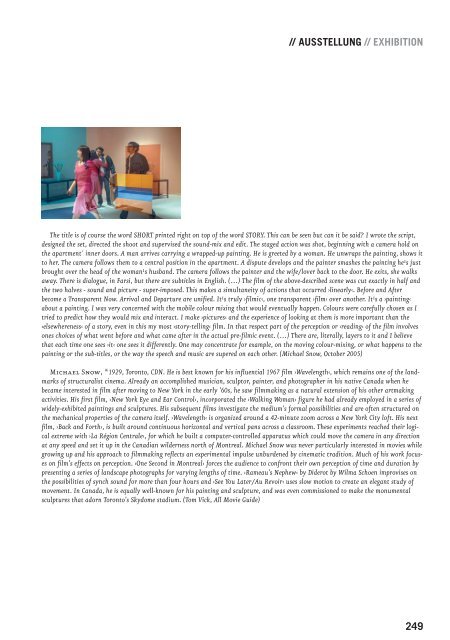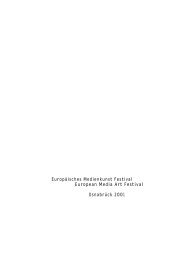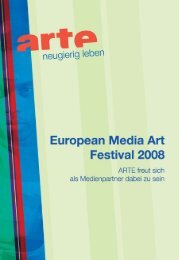Create successful ePaper yourself
Turn your PDF publications into a flip-book with our unique Google optimized e-Paper software.
AUSSTELLUNG // EXHIBITION<br />
The title is of course the word SHORT printed right on top of the word STORY. This can be seen but can it be said? I wrote the script,<br />
designed the set, directed the shoot and supervised the sound-mix and edit. The staged action was shot, beginning with a camera hold on<br />
the apartment´ inner doors. A man arrives carrying a wrapped-up painting. He is greeted by a woman. He unwraps the painting, shows it<br />
to her. The camera follows them to a central position in the apartment. A dispute develops and the painter smashes the painting he¹s just<br />
brought over the head of the woman¹s husband. The camera follows the painter and the wife/lover back to the door. He exits, she walks<br />
away. There is dialogue, in Farsi, but there are subtitles in English. (…) The film of the above-described scene was cut exactly in half and<br />
the two halves - sound and picture - super-imposed. This makes a simultaneity of actions that occurred ›linearly‹. Before and After<br />
become a Transparent Now. Arrival and Departure are unified. It¹s truly ›filmic‹, one transparent ›film‹ over another. It¹s a ›painting‹<br />
about a painting. I was very concerned with the mobile colour mixing that would eventually happen. Colours were carefully chosen as I<br />
tried to predict how they would mix and interact. I make ›pictures‹ and the experience of looking at them is more important than the<br />
›elsewhereness‹ of a story, even in this my most ›story-telling‹ film. In that respect part of the perception or ›reading‹ of the film involves<br />
ones choices of what went before and what came after in the actual pre-filmic event. (…) There are, literally, layers to it and I believe<br />
that each time one sees ›it‹ one sees it differently. One may concentrate for example, on the moving colour-mixing, or what happens to the<br />
painting or the sub-titles, or the way the speech and music are supered on each other. (Michael Snow, October 2005)<br />
Michael Snow, *1929, Toronto, CDN. He is best known for his influential 1967 film ›Wavelength‹, which remains one of the landmarks<br />
of structuralist cinema. Already an accomplished musician, sculptor, painter, and photographer in his native Canada when he<br />
became interested in film after moving to New York in the early '60s, he saw filmmaking as a natural extension of his other artmaking<br />
activities. His first film, ›New York Eye and Ear Control‹, incorporated the ›Walking Woman‹ figure he had already employed in a series of<br />
widely-exhibited paintings and sculptures. His subsequent films investigate the medium's formal possibilities and are often structured on<br />
the mechanical properties of the camera itself. ›Wavelength‹ is organized around a 42-minute zoom across a New York City loft. His next<br />
film, ›Back and Forth‹, is built around continuous horizontal and vertical pans across a classroom. These experiments reached their logical<br />
extreme with ›La Région Centrale‹, for which he built a computer-controlled apparatus which could move the camera in any direction<br />
at any speed and set it up in the Canadian wilderness north of Montreal. Michael Snow was never particularly interested in movies while<br />
growing up and his approach to filmmaking reflects an experimental impulse unburdened by cinematic tradition. Much of his work focuses<br />
on film's effects on perception. ›One Second in Montreal‹ forces the audience to confront their own perception of time and duration by<br />
presenting a series of landscape photographs for varying lengths of time. ›Rameau's Nephew‹ by Diderot by Wilma Schoen improvises on<br />
the possibilities of synch sound for more than four hours and ›See You Later/Au Revoir‹ uses slow motion to create an elegant study of<br />
movement. In Canada, he is equally well-known for his painting and sculpture, and was even commissioned to make the monumental<br />
sculptures that adorn Toronto's Skydome stadium. (Tom Vick, All Movie Guide)<br />
249












